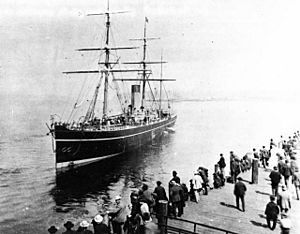SS Abyssinia facts for kids

SS Abyssinia at Vancouver, June 1887
|
|
Quick facts for kids History |
|
|---|---|
| Name | Abyssinia |
| Namesake | Abyssinia |
| Owner |
|
| Route | |
| Builder | J & G Thomson, Govan |
| Yard number | 110 |
| Launched | 3 March 1870 |
| Completed | May 1870 |
| Fate | Caught fire and sank, 18 December 1891 in the North Atlantic off Nova Scotia. |
| General characteristics | |
| Type | iron-hulled steamship |
| Tonnage | 3,253 GRT |
| Length | 364 ft (111 m) |
| Beam | 42 ft (13 m) |
| Propulsion | steam engine |
| Speed | 13 knots (24 km/h; 15 mph) |
The SS Abyssinia was a British mail ship. It was built in 1870 and first sailed for the Cunard Line. The ship carried mail and passengers between Liverpool, England, and New York City. Later, it worked for the Guion Line on the same route. It also served the Canadian Pacific Line in the Pacific Ocean. In December 1891, the Abyssinia caught fire in the middle of the Atlantic. Everyone on board was rescued safely before the ship sank. The fire started in its cargo of cotton. This event showed how risky it was to carry both cotton and people on the same ship.
Contents
Building and Design of the Ship
Creating a New Fleet
After the success of SS Russia, the Cunard Line wanted new, fast ships. These ships were needed for the important mail route to New York. The Abyssinia was the fourth of five ships ordered for a weekly service.
Passenger Capacity and Speed
The Abyssinia and its sister ship, Algeria, were special. They were the first Cunard express ships designed to carry many passengers in the lower decks. This type of travel was called "steerage" and had proven to be very profitable. When finished in 1870, the Abyssinia could carry 200 first-class passengers. It also had room for 1050 steerage passengers. The ship could travel at about 12.5 knots (about 23 kilometers per hour). This was a bit slower than the Russia.
Ship's Journeys and History
Early Years with Cunard
Cunard used the Abyssinia for trips between Liverpool, Queenstown (now Cobh), and New York. However, new ships from the White Star Line, like the Oceanic in 1871, quickly made Cunard's ships seem old-fashioned. For example, the Abyssinia used 90 tons of coal each day. The Oceanic used only 58 tons. Other shipping companies quickly updated their ships. Cunard, however, did not upgrade the Abyssinia right away.
Rescue at Sea
In November 1873, the Abyssinia made an important discovery. Its crew found an American ship called R. Robinson floating empty in the Atlantic Ocean. Some of the Abyssinia crew went aboard. They managed to bring the R. Robinson safely to Halifax, Nova Scotia, in Canada.
Changes in Ownership
In 1880, Cunard sold the Abyssinia to the Guion Line. Guion needed a mail ship to replace one they had lost. Two years later, the Abyssinia finally got new, more efficient engines. In 1884, the ship was part of a deal. It was used to help pay for Guion's new, very fast ship, the Oregon. However, Guion could not make the payments for the Oregon. So, they returned the new ship and kept operating the Abyssinia.
Pacific Adventures
In 1887, the Abyssinia was leased to William Van Horne. He wanted to start a new shipping service in the Pacific Ocean. This service would connect with the Canadian Pacific Railway. The idea was to create a travel route from England, across the Atlantic by ship, across Canada by train, and then across the Pacific by ship to Asia.
The Abyssinia started this new Pacific service. It carried 22 first-class passengers and 80 steerage passengers. It took only 13 days for the ship to travel from Yokohama to Vancouver. This set a new record for crossing the Pacific. The ship's cargo of silk and tea was then put on trains. It reached New York and then London, completing a fast journey from Asia to Europe. The Abyssinia returned to the Guion Line when Canadian Pacific received its own new "Empress" ships.
The Final Voyage
Guion put the Abyssinia back on its old route between Liverpool, Queenstown, and New York. On December 13, 1891, the ship left New York heading east. It had 57 passengers and 88 crew members. It also carried various goods, including cotton.
At 12:40 pm on December 18, 1891, a fire broke out. The ship was off the coast of Newfoundland. The fire started in the cargo hold and quickly grew too big for the crew to fight. Captain G.S. Murray ordered everyone to leave the ship. Another ship, the Spree, saw the smoke from the Abyssinia. By 4:15 pm, all passengers and crew were safely transferred to the Spree. The Abyssinia sank soon after. The Spree arrived in Southampton with the survivors on December 21.
Other Information
- Vancouver: From Milltown to Metropolis, Alan Morley, Mitchell Press, Vancouver (1961), pp. 97–99.

